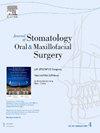Ki67作为增殖标志物:牙源性角化囊肿和根状囊肿的研究。
IF 2
3区 医学
Q2 DENTISTRY, ORAL SURGERY & MEDICINE
Journal of Stomatology Oral and Maxillofacial Surgery
Pub Date : 2025-03-10
DOI:10.1016/j.jormas.2025.102313
引用次数: 0
摘要
Ki67作为一种增殖标志物,在评估包括囊性病变在内的各种病理组织的细胞活性方面起着关键作用。牙源性角化囊肿(OKCs)和根状囊肿(RCs)是两种常见的颌囊肿类型,它们表现出不同的生物学行为,尤其是它们的增殖模式。OKCs以其侵袭性和高复发率而闻名,而rc通常侵袭性较低,复发风险较低。通过评估Ki67(一种与细胞增殖相关的核蛋白)的表达,研究人员可以对这些囊肿的生长潜力和复发倾向获得有价值的见解。该研究包括分析来自OKCs和RCs患者的32个活检样本,使用免疫组织化学技术评估Ki67表达水平。这些样本被手术切除并准备进行组织学检查,在囊上皮的基底层和基上层定量检测ki67阳性细胞。结果表明,OKCs在基底层具有较高浓度的ki67阳性细胞,而RCs在基底层和基上层均具有增殖活性。这种不同的模式突出了OKCs更具侵略性的增殖行为。统计分析证实了两种囊肿类型之间Ki67表达的显著差异,强调了该标记物在区分OKCs和RCs中的重要性。Ki67在OKCs基底层的有限表达,而不是在RCs中更广泛的分布,表明OKCs具有更高的增殖潜力,导致其复发率增加。本文章由计算机程序翻译,如有差异,请以英文原文为准。
Ki67 as a proliferation marker: A study on odontogenic keratocysts and radicular cysts
Ki67 as a proliferation marker plays a critical role in assessing cellular activity in various pathological tissues, including cystic lesions. Odontogenic keratocysts (OKCs) and radicular cysts (RCs) are two common types of jaw cysts that exhibit distinct biological behaviors, particularly in their proliferative patterns. OKCs are known for their aggressive nature and high recurrence rate, while RCs are typically less aggressive and exhibit lower recurrence risk. By evaluating the expression of Ki67, a nuclear protein linked to cell proliferation, researchers can gain valuable insights into the growth potential and recurrence tendencies of these cysts.
The study involved analyzing 32 biopsy samples from patients with OKCs and RCs, using immunohistochemical techniques to assess Ki67 expression levels. These samples were surgically removed and prepared for histological examination, with Ki67-positive cells quantified in both basal and suprabasal layers of the cystic epithelium. The findings revealed that OKCs exhibited a higher concentration of Ki67-positive cells in the basal layers, while RCs showed proliferative activity in both basal and suprabasal layers. This differential pattern highlights the more aggressive proliferative behavior of OKCs.
The statistical analysis confirmed significant differences in Ki67 expression between the two cyst types, underscoring the importance of this marker in differentiating OKCs from RCs. The confined expression of Ki67 in the basal layer of OKCs, as opposed to the broader distribution in RCs, suggests that OKCs have a higher proliferative potential, contributing to their increased recurrence rates.
求助全文
通过发布文献求助,成功后即可免费获取论文全文。
去求助
来源期刊

Journal of Stomatology Oral and Maxillofacial Surgery
Surgery, Dentistry, Oral Surgery and Medicine, Otorhinolaryngology and Facial Plastic Surgery
CiteScore
2.30
自引率
9.10%
发文量
0
审稿时长
23 days
 求助内容:
求助内容: 应助结果提醒方式:
应助结果提醒方式:


